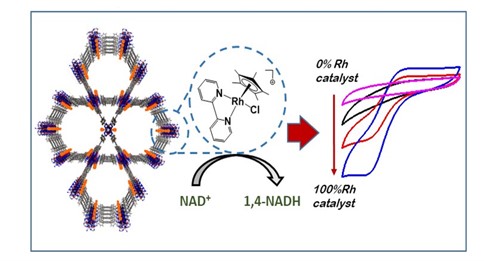W. Li, C. Zhang, Z. Zheng, X. Zhang, L. Zhang, A. Kuhn
ACS Appl. Mater.& Inter. 14 (2022) 46673–46681
Electrochemical regeneration of the reduced form of the nicotinamide adenine dinucleotide (NADH) cofactor catalyzed by immobilized [Rh(Cp*)(bpy)Cl]+ is a promising approach for enzymatic synthesis of many valuable chemicals with NAD-dependent dehydrogenases. However, a rational control of the efficiency is often limited by the irregular structure of the electrode/electrolyte interface and the accessibility of the molecular catalyst. Here, we propose an electrochemical system for NADH cofactor regeneration, based on highly ordered 3D metal-organic framework (NU-1000) films. [Rh(Cp*)(bpy)Cl]+ is incorporated at the zirconium nodes of NU-1000 via solvent-assisted ligand incorporation (SALI), leading to a diffusion-controlled behavior, associated with an electron hopping mechanism. Varying the ratio of redox-active [Rh(Cp*)(bpy)Cl]+ and inactive post-grafting agents enables the elaboration of functional electrodes with tunable electrocatalytic activity for NADH regeneration. The exceptionally high Faradaic efficiency of 97%, associated with a very high turnover frequency (TOF) of ~1400 h-1 for NADH regeneration, and the total turnover number (TTN) of over 20000 for the enzymatic conversion from pyruvate to L-lactate, when coupled with L-Lactate dehydrogenases (LDH) as a model reaction, open up promising perspectives for employing these electrodes in various alternative bioelectrosynthesis approaches.







